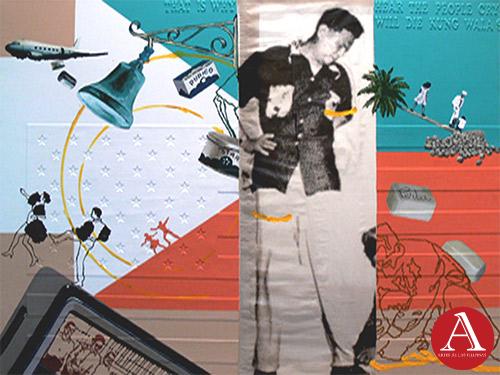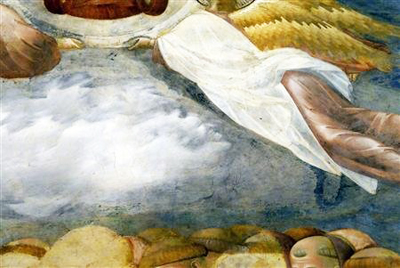
JOSE JOHN SANTOS III’S SUBCONSCIOUS UPWELLINGS
by: Christiane de la Paz
February 2010 — While many of the ideas of the young artists today swirled in chaotic orbits, Jose John Santos’ paintings remain simple and fantastic and are always governed by thought. In many of his outputs, he challenges his viewer’s intellect and assumptions about reality by putting forward his subconscious upwellings and conjunctions of seemingly unrelated objects which gives new meanings to many familiar things. His art also juxtaposes the classic and the contemporary (note that even his first two names marry the old and the new), the iconic and the everyday as well as painting and photography. He uses the former to explore how the latter constructs or represents reality. While some collectors proclaim his achievements both truthful and beautiful; others salute his talent as an embodiment of greatness and a token of quality. In this interview, Jose John Santos tells his emergence as a young painter, the phases of his works, his wit and sensibility and why he continues to be one of the most sought young artists of today.
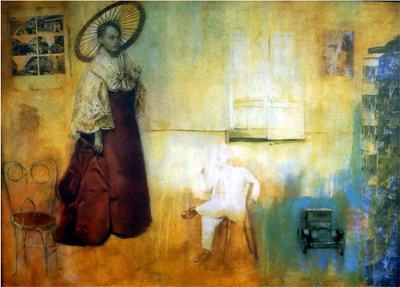
Promenade (2002)
48 x 66 inches, mixed media
After graduating from the University of the Philippines in 1997, what was your life like during the early phase of your career?
Life as an artist back then was not as fast-paced as it is now. Before, I had time to have light yet intense artistic discussions not only in school but also with my artist peers. It was relaxed but I don’t mean it to be lazy relaxed but I seemed to have a lot more time. Artists now have more opportunities so things kind of go a lot faster.
Was Fine Arts your first course in college?
No.My first course was sports science at the College of Human Kinetics then I went to advertising before I finally shifted to painting.
Why sports science?
I was into sports when I was younger. I played basketball, table tennis, competed with a rowing team in college and was into cycling. I sometimes rode my bike from home to school.
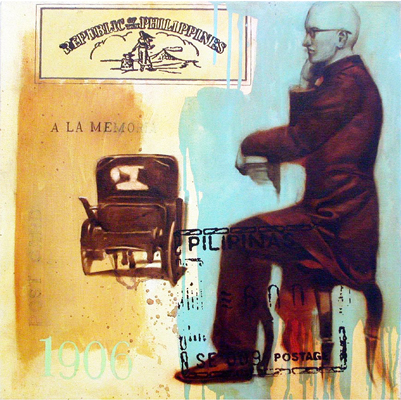
A La Memoria (2004)
mixed media
You completed your college education in a span of ten years. That is beyond the maximum residence required of a student.
I wrote a letter to the student affairs a few times and so I was able to finish my college education eventually. I was fortunate to have been introduced to people who got me involved in the practice of art outside of school. When I was practicing art alongside my school work, school work kind of took the backseat. I’m not saying that it’s the right thing to do but somehow when you’re young and you’re an aspiring artist, you kind of choose the more direct route in becoming one. And when the opportunities to show my works came, which I think was pretty rare for young artists at that time, I just grabbed each opportunity because you don’t get to choose.
Would you consider yourself an average or above average student?
Let’s just say that I know my capacities but I did just enough to get through the courses especially the ones that I don’t like. I wasn’t the most diligent student that’s for sure and a few of my professors can attest to that.
What are some of your not so favorite subjects in college that you need to take to finish?
I hated the Communication and Speech subjects.
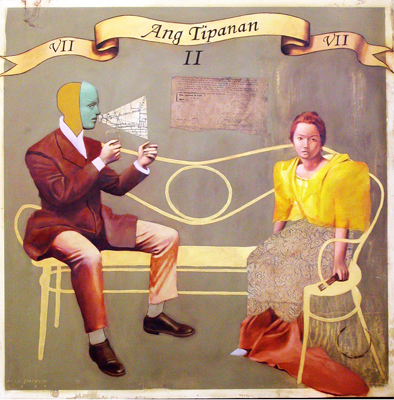
Ang Tipanan (2004)
mixed media
In terms of style, who were you drawn to painting during your student years?
I was drawn to the works of Francis Bacon, Robert Rauschenberg, a bit of Jasper Johns, the photographer Joyce Tenesson and some of the Surrealists.
Who are your batchmates?
As I don’t really know which particular batch I belong to, I’ll just enumerate the artists whom I got to be classmates with and who are still active in the exhibition circuit today: Erwin Leano, Jim Orencio, Reymar Gacutan, Annie Cabigting, Jucar Raquepo, Dansoy Coquilla, Mikel Parial. I might have missed out some but they are that immediately come to mind.
Among your batchmates, who do you think will become commercially successful as an artist?
I don’t know. Being commercially successful back then was not really part of the equation. All we really wanted was to go out and show our works. Selling our works just came as a big bonus.
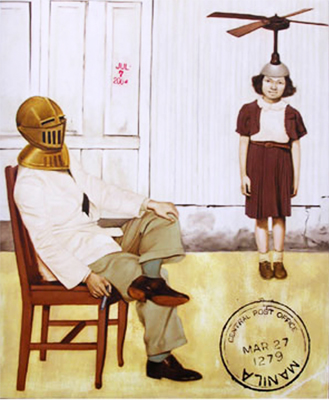
Knight Scene (2005)
mixed media
What was the first job you applied for?
I taught at the UPCFA and taught there for the next seven years but even before that I had a few sideline jobs during my college years. I had an illustrating stint with Batibot, the children’s program, where I did scenes for the storytelling segment. I also did caricature illustrations for the Rotary Club of Pasig which they used for a medical books. And then I taught at St. Paul’s Pasig.
How did this teaching offer come about?
A friend of mine from college who was taking advertising was the one who was teaching there and she invited me as her replacement when she left her teaching position. That was in 1994. I taught there for six years.
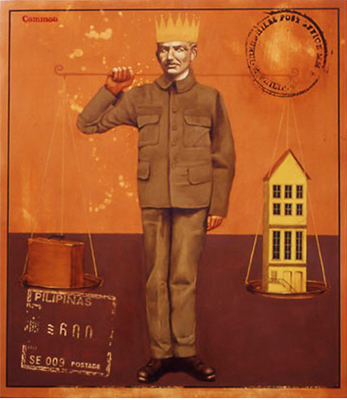
The Scale (2005)
mixed media
After this stint, did you then apply as a faculty at the UPCFA?
The two teaching positions actually overlapped for around three years. I started teaching in UPCFA in 1997 right after I graduated. I taught drawing and painting techniques classes although there were a few semesters when I also taught visual perception and advance visual studies courses.
While having your day job as a teacher, were you making any efforts in becoming active in the art scene?
Yes, I did. While I find teaching gratifying, making art gave me a different high. I kind of felt like I could not teach effectively if I am not creatively active because I somehow felt that I could be a better mentor if I could draw my teaching inspiration from my own practice. Teaching was one of the offshoots of my practice. Although admittedly I could have been more visible in the art scene.
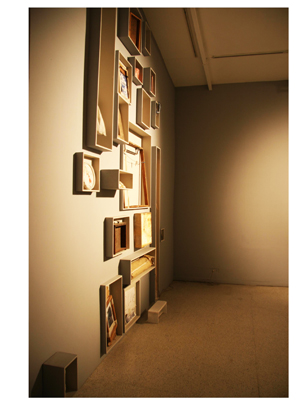
Did you first enter the art scene as a conceptual artist?
No. I was doing mixed media and assemblage works combined with some painting in my early years.
What made you decide to focus on painting?
It’s not really a categorical shift like a total and sudden change. First the objects began to disappear while some of the collage remained and painting became more dominant until only painting remained. Although I’m generally known by my narrative figurative work, I’ve had intermittent excursions to explore some mixed media concerns.
Tell me about your first exhibit.
The first exhibit I participated in was a group show at Dr. Joven Cuanang’s garden in Antipolo. It was literally in the garden. The small scale watercolors of Dr. Cuanang’s icon collection were hung on 2 x 2 inch wooden frameworks. The turn-out was good. I don’t know if there were any reviews for that show.
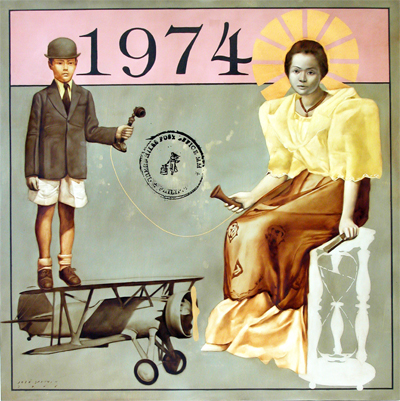
The Connection (2005)
mixed media
Do you agree that the first exhibit of a painter can make or break his career?
This is not true. Most people don’t know what I did for the first show that I joined.
What did you do with the income you generated from the sales?
I bought art materials.
What was the first gallery that took an interest in your works?
Boston Gallery
Are you exclusive to Boston Gallery?
I’m not exclusive to Boston. If I like the space and the schedule permits, I exhibit my works in other galleries. But I usually work with galleries with whom I have long- standing affiliations.
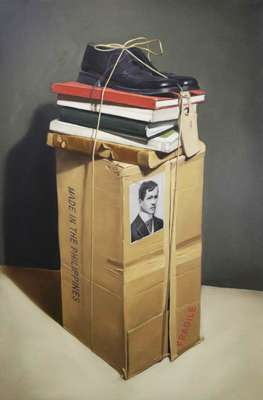
Balikbayan Box (2007)
oil on canvas
When you have an upcoming exhibit, how do you prepare for it mentally?
I try to recognize the variables like time frame, the ideas for the show and the process involved which also affects the time frame. Of these factors, time for me is the most important as it allows more conceptualizing done and more physical progress for the actual work. All these variables affect the artist mentally on both the emotional and intellectual levels. Ideas can be drawn from anywhere and at anytime and often times from unexpected sources. One crucial thing to note is the ability to recognize and identify these ideas when they present themselves and to not forget about them. Thes are the times when a visual journal and pen come in handy.
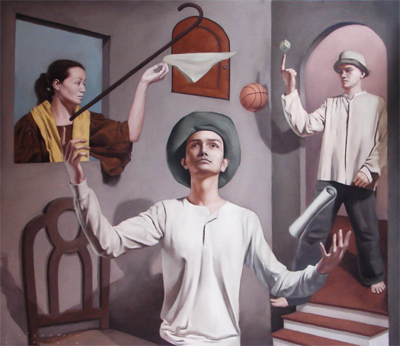
Untitled (2007)
Is there an effort on your part to paint subjects differently?
Being different or unique will come naturally if you search within yourself. An artist must be honest about his personal sensibilities and must have the ability to distill and transform these sensibilities into a visual language that is unique. The combination of these sensibilities will make one’s visual language original or unique. I don’t see it as being unique for the sake of being different because this could be pretentious and shallow. I see it as being unique because that’s what you’re all about.
When and how did you become a member of the Grupong Salingpusa?
In 1989. I became a close friend of Erwin Leano and Jim Orencio. Both of them had older brothers in the group. That’s pretty much how I got in.

Here and There (2007)
mixed media
Some group requires a talent test and elder members acts as evaluators. Some are taken in through the recommendation of other group members. In your case with Salingpusa, Erwin and Jim just invited you in?
They didn’t really get me in and neither did I have the intention of joining. It was more like I was absorbed in the group. There were no papers to fill up or set of listed qualifications to be accepted. The process was very organic to say the least. When I started going to Antipolo, I met the group’s senior members. After that, when there were projects or activities they invite me to come along and participate. I guess I was a salingpusa (a Filipino word that refers to an individual who is made a member of a group even though he does not possess all the requirements for membership) but in the true sense of the word. I don’t know when exactly I became part of the group but all I knew was that I was part of a lot of the projects they were doing.
What do you think are the advantages of being part of an artist’s group?
You tend to feel stronger when you are in a group. The responsibility seems to diminish as a group gets bigger especially if you are one of the younger members in the group.
And the disadvantages?
I became too dependent on the senior members especially the main movers of the group. I developed the go with the flow attitude.
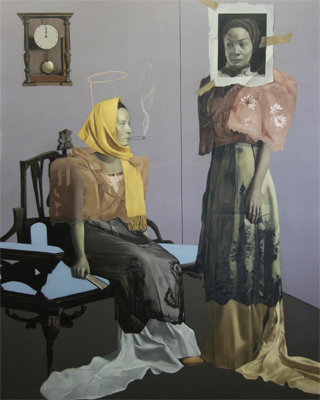
Curfew
oil on canvas
Who are these senior members you are refering to?
Mark Justiniani, Karen Flores, Tony Leano, Elmer Borlongan, Manny Garibay, Ferdie Montemayor, Neil Manalo.
From the time you began painting professionally, have you won any important award?
Yes, the most important one is the CCP 13 Artists Award. I also got an award in UP while I was teaching in college, the Outstanding Visual Creation Award given by the UP Chancellor.
Do you think awards help make the painter become commercially recognized?
I think it does to some degree because an award is one type of validation that is tangible and quantifiable. It’s an easier way of assessing and appraising value.
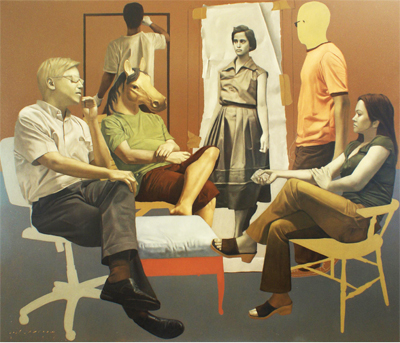
Curfew (2008)
Do you think a painter can become commercially successful without receiving any award?
I think so.
If an artist has not won any award and has not participated in important exhibitions, how do you think an artist can prep up his resume?
I think that before the exhibitions, projects, accolades, resume, it has to begin with the desire to create. After this, everything else follows.
Is there any award that you wished you have won?
I got nominated at this one award and at that time I wished I had won it.
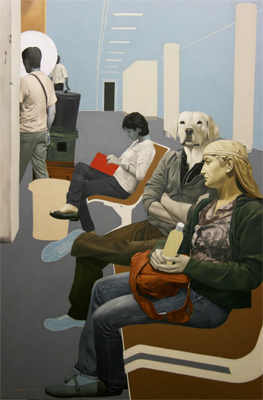
Junction (2008)
Who are the local painters who had an influence in your art?
The senior members of the Grupong Salingpusa had a very strong influence on me as a young artist. Influential also would be my mentors back in college in the UPCFA: Professors Ruben David Defeo, Roberto Chabet, Dan Raralio.
What about foreign influences?
Joyce Tenneson had an influence on my work especially in the late 1990s up to the early 2000s. I was drawn to the mystical aura of her works. Then in the early 90s, I began to admire the works of American Pop artists. At that time, while I was enamored to the spirituality of Tenneson’s works, I also found the attention given by the Pop artists to things worldly and mundane quite brave. For me, to successfully recast the banal into art was really admirable because of its boldness.
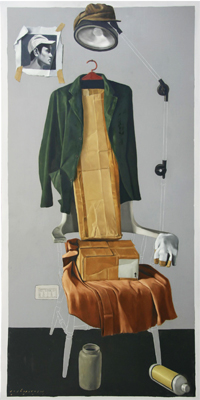
Portrait (2008)
Has your parents or siblings seen your works? What do they have to say about your works?
My parents and sister are familiar with my works but I don’t know if my parents understand them. They belong to a different time and sensibility. They just go like “It’s nice, where are you exhibiting them?” but I don’t really think they understand what my work is all about but my sister digests its essence more than they do.
In the contemporary art scene, younger artists are quickly making their way by virtue of being auctioned. What is your position on this?
The artist gets a bigger exposure in the auction scene. A lot more people get to see an artist’s works on an international stage. But I believe that there should be a good track record behind the soaring prices that auction pieces can command. That’s why being active in the exhibition circuit should always rank high in an artist’s list of priorities. Otherwise, the hollowness of these prices could be exposed sooner or later.
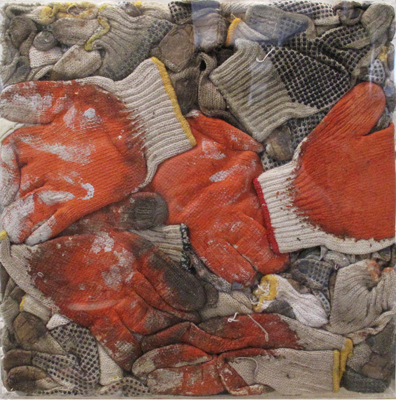
Hand Made (2008)
Do you think that being auctioned abroad a measure of success for an artist?
Yes. I guess if his or her work performs well in the auction.
How do you feel that your works gets higher in value each year? Is there an effort on your part to allow other collectors to afford your work?
The increase in price is natural. It just follows the increase in prices of everything around us. What I don’t do is to increase my prices arbitrarily. This by itself allows my works to be affordable by still many collectors.
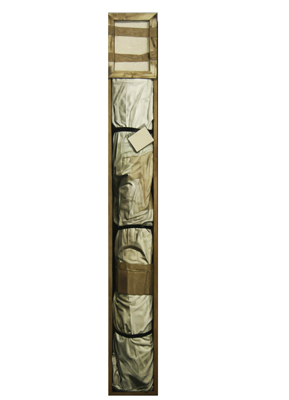
Untitled (2009)
Have you ever helped an institution by donating your work?
Yes. I’ve donated some works for an auction for overseas Filipinos. One work I donated for a religious organization. They asked me again last year but unfortunately I didn’t have an avaialable work to donate.
Do you always accommodate requests to donate your work for a cause? How do you qualify these requests?
I try to do so when I can. If I know the people and I have something available to give then it’s easier.
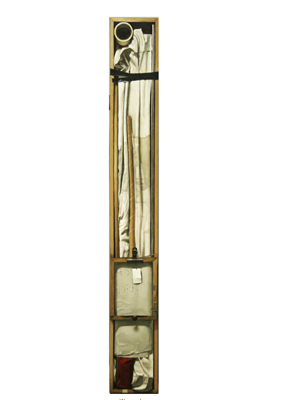
Wrapped (2009)
Who handles the business side of your profession?
Mostly, the galleries that I work with do the business side.
Do you have an idea of the profile of collectors who buy your works?
Yes but only for some of them. A few have become very good friends.
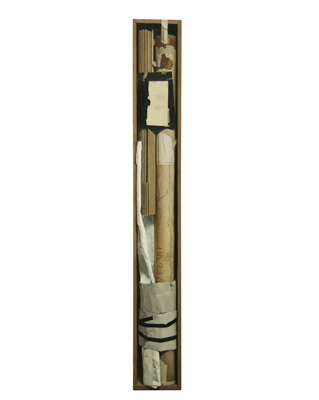
Rolled Up (2009)
Since a few of them have become good friends, do you give them your “better” works?
It’s usually the gallery that handles it. I don’t choose to whom the works go.
Do you enjoy commissioned works?
Generally, I do because I get a lot of freedom in doing the works. There are times that requests become so specific and it becomes hard to adjust. The artist can say no if he feels that his creative freedom is being sacrificed.
Have you also had clients from hell? Clients who’d request you to do something that you think is not your style or point of view. How do you deal with them?
Yes I did, once. That’s why I let the gallery deal with the business side.
Let’s say someone approached you for a commission work and your customer informed you that he can only pay you below your market value, would you accommodate his request?
I would still tell the person to deal with the gallery.
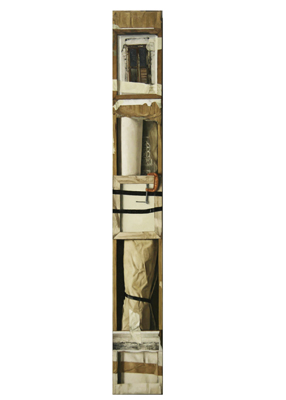
Clamped (2009)
Throughout the year, are you more occupied painting for an exhibit or doing commissioned works?
Neither. I’m more occupied preparing for exhibits.
Do you believe in being reviewed for every exhibit you participated in? Do you prefer professors to review your works or anyone for that matter?
It’s nice if there will be a feature or review for a show. It helps a lot in the exposure of what an artist has done even long after an exhibit is over. I would prefer someone who understands what the artist is about.
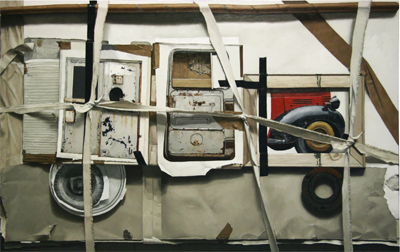
Relief (2009)
What has been the best thing written about you?
I can’t remember the best thing that has been written about my works but what I remember clearly is when someone personally said, “Thank you for what you’ve given us.” This was back in the 1990s.
And what has been the worst?
The worst I guess was when someone said that the works I did for a show in the mid- 1990s was just a rehash of my previous works.
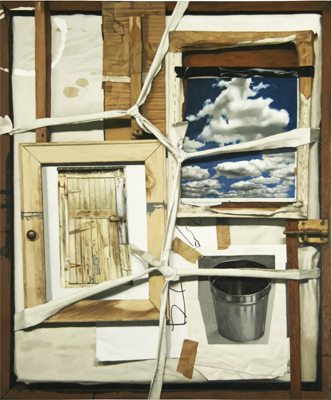
Weathervane (2009)
How do you make an effort to explain your insight or do you just let it pass?
You mean about my works? I explain them if I need to.
I noticed that some collectors ask artists to explain their views about their works, how do you feel about this? I know you are not much of a big talker.
I’m not a big talker but I’m ok when it comes to explaining what my work is all about.
When you are in the process of working, who exactly is the viewer you have in mind?
I think when an artist works, he or she should always be the viewer. Eventually the art work will find its own viewers.
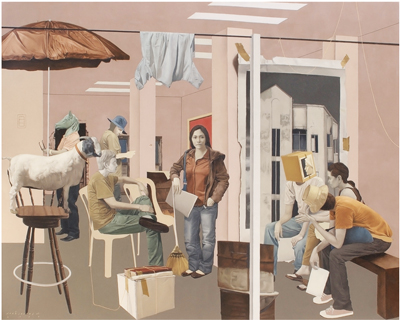
Behind the Scenes (2009)
On a lighter note, I’m sure you are aware that you share the same name as the actor-comedian, Jon Santos. How do you feel about this when someone asks you?
It’s ok. I just joke about it.
Have you met him?
Not yet.
You were born and raised in Pasig City. Are you aware of past and present artists who are residents of the city?
Francisco Coching , Juan Alcazaren, Cenon Rivera, Manuel Baldemor, Ambrosio Morales.

Lifeline
What are your other intereststs?
Eating good food, fixing things, mysteries and the mystical, sports, animals, driving when there’s no traffic and nature.
I know that you are an advocate of animal’s rights and is also a vegan. How did this advocacy and lifestyle come about?
I used to be a vegan only for a short time. It was hard. I easily get hungry. I am less strict with the diet nowadays. I eat seafoods but I still don’t eat animals that walk or crawl on the ground or fly in the air. There was this time that I had an intestinal flu and all I ate was lugaw for days. I didn’t have any problems with it and that was the time I decided to stop eating meat. This was around fifteen years ago.
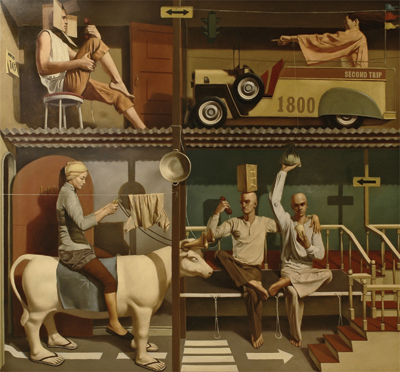
Crossover
In 2007, you had an accident while scraping paint from its tube. Tell me about this.
Painting can be a dangerous job if you’re stupid. I was trying to get every ounce of the paint out of the tube by using a cutter. The cutter slipped and I cut my left radial artery. I will spare you the gory details of what happened that day but one thing I learned was that what you see in horror movies is not far from the truth. For a while, I got traumatize of sharp objects. Then I went back to painting two days after I got discharged from the hospital.
You are married to Pam Yan. What are the advantages of being married to a fellow artist?
Two sets of eyes are better than one.
And the disadvantages?
More space to work and more space to store materials. A lot of the materials we use are different.

One Mind
How do you try to avoid having professional jealousy?
It’s human to experience things like that and artists are human just like everyone else. But the good thing is, we differ in our visual language so these things are easily avoided. The important thing is we focus on being a tandem than by being an individual. It makes the relationship stronger.
What do you think is in your work that will make it stand the test of time?
That is really a hard question. Firstly, I still consider myself young in terms of my career as an artist. Being young, it becomes hard for me to see myself in the context of history, at least not yet or maybe not at all. This is something that I feel that artists should not be conscious about. Secondly, it’s not for me to say how I will be seen in the context of history.
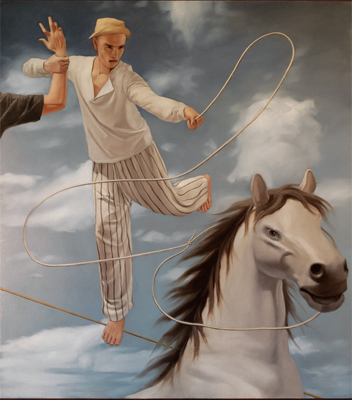
Muling Pagsubok


